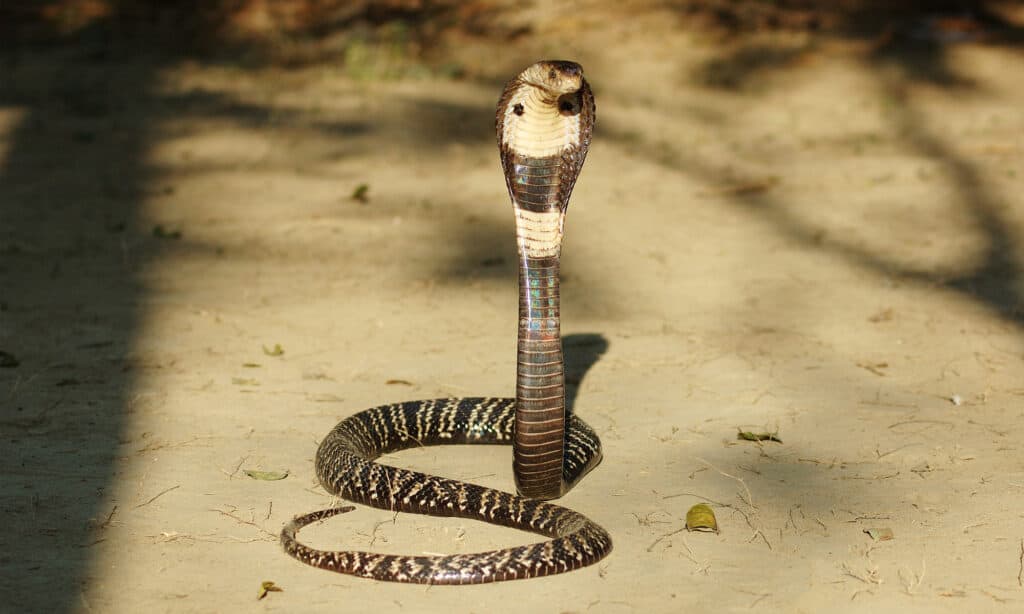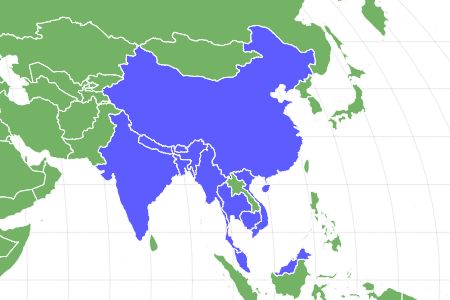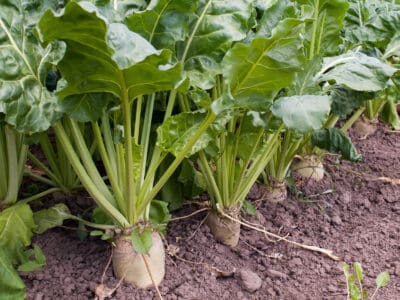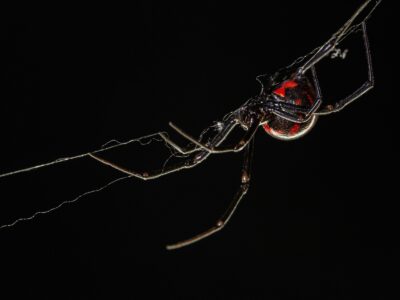Monocled Cobra
.jumbotron {
background-image: url(“https://a-z-animals.com/media/2022/05/monocled-cobra-naja-kaouthia-also-called-monocellate-cobra-or-indian-picture-id13587374881-400×300.jpg”);
}
}
@media only screen and (min-width: 641px) and (max-width: 920px) {
.jumbotron {
background-image: url(“https://a-z-animals.com/media/2022/05/monocled-cobra-naja-kaouthia-also-called-monocellate-cobra-or-indian-picture-id13587374881-470×370.jpg”);
}
}
@media only screen and (min-width: 921px) {
.jumbotron {
background-image: url(“https://a-z-animals.com/media/2022/05/monocled-cobra-naja-kaouthia-also-called-monocellate-cobra-or-indian-picture-id13587374881.jpg”);
}
}
Monocled Cobra
Naja kaouthia
The monocled cobra is responsible for the highest fatality rate of any snake in all of Thailand.
Monocled Cobra Scientific Classification
- Kingdom
- Animalia
- Phylum
- Chordata
- Class
- Reptilia
- Order
- Squamata
- Family
- Elapidae
- Genus
- Naja
- Scientific Name
- Naja kaouthia
Read our Complete Guide to Classification of Animals.
Monocled Cobra Conservation Status
Monocled Cobra Facts
- Fun Fact
- The monocled cobra is responsible for the highest fatality rate of any snake in all of Thailand.
- Estimated Population Size
- Unknown
- Biggest Threat
- Habitat loss and deliberate hunting (by humans)
- Most Distinctive Feature
- Round monocle shape on the back of the hood, sometimes accompanied by crossbands
- Distinctive Feature
- Some monocled cobras have pale yellow crossbands along the length of their body
- Other Name(s)
- Indian spitting cobra
- Incubation Period
- Approximately 2 months
- Habitat
- Grasslands, forests, shrub lands, swamps, and agricultural fields
- Predators
- Eagles and king cobras
- Diet
- Omnivore
- Lifestyle
-
- Crepuscular
- Favorite Food
- Rodents, lizards, snakes, frogs, and toads
- Common Name
- Monocled cobra
Monocled Cobra Physical Characteristics
- Skin Type
- Scales
- Venomous
- Yes
- Aggression
- High
This post may contain affiliate links to our partners like Chewy, Amazon, and others. Purchasing through these helps us further the A-Z Animals mission to educate about the world’s species..

Discover alligator-eating snakes, spiders larger than your phone, and 1000 more incredible animals in our daily FREE email.
.photo-gallery {
–margin: 0px auto 0px;
–padding: 0px 0px 0px 0px;
}
.gallery-link {
background-image: url(“https://a-z-animals.com/media/2022/01/Spitting-cobra-baby-1024×535.jpg”);
background-repeat: no-repeat;
background-size: cover;
background-position: center;
height: 500px;
justify-content: center;
text-align: center;
align-items: center;
display: flex;
border: 2px solid #000;
}
.gallery-link img {
height: 50%;
}
@media only screen and (max-width: 768px) {
.gallery-link {
height: 300px !important;
}
}
View all of the Monocled Cobra images!
The monocled cobra is among the most dangerous snakes in the world.
The monocled cobra, also known as the Indian spitting cobra, produces a lethal amount of venom that acts quickly to target the nervous system of its victim. While not quite as well known as the Indian cobra, it is nevertheless fairly common throughout South Asia. This species should be avoided at all costs.
4 Monocled Cobra Amazing Facts
- The reproductive season of the monocled cobra usually takes place near the end of the year. After mating, the female can lay anywhere between 16 and 45 eggs per clutch in a small burrow. The eggs take about two months to hatch. The juveniles will have fully functioning venom glands from the moment they emerge from the eggs. They have about two weeks before their yolk sac is exhausted and they must begin to hunt for themselves.
- The monocled cobra is preyed upon by eagles and king cobras. However, very few predators will ever want to take a chance by attacking this dangerous snake.
- The monocled cobra is most active during the hours around sunset, when they come out from their hiding spot to hunt for food.
- Due to the snake’s ability to spit venom, it is also given the alternate name of Indian spitting cobra.
Where to Find Monocled Cobras
The monocle cobra is found in grasslands, forests, shrublands, swamps, and agricultural fields throughout South Asia where they have a plentiful diet. They spend a lot of their time hiding in burrows and holes to avoid predators and come out at sunset to hunt for food. Here is a complete list of the countries where they can be found:
button.pulse {
transform: scale(1); animation: pulse 2s infinite;
box-shadow: 0 0 0 0 rgba(11, 247, 25, 1);
}
@keyframes pulse {
0% { transform: scale(0.90); box-shadow: 0 0 0 0 rgba(11, 247, 25, 0.5); }
60% { transform: scale(1); box-shadow: 0 0 0 15px rgba(11, 247, 25, 0); }
100% { transform: scale(0.90); box-shadow: 0 0 0 0 rgba(11, 247, 25, 0); }
}
Scientific Name
The scientific name of the monocle cobra is Naja kaouthia. Naja is derived from the Sanskrit (a South Asian language) word for snake. Kaouthia is likewise derived from a Bengali word that simply means monocle. The monocled cobra was once considered to be a subspecies of the spectacled cobra, but after further analysis, it was later elevated to its own species. It is closely related to the Indian cobra, Egyptian cobra, and other types of cobras in the same genus.
Population & Conservation Status
According to the IUCN Red List, the monocle cobra is considered to be a species of least concern. Population numbers are unknown, but they do appear to be decreasing in some parts of its range, perhaps due to habitat loss and deliberate hunting. It is still thought to be very common and widespread.
How to Identify the Monocled Cobra: Appearance and Description
The monocled cobra is characterized by a long gray or brown body which may or may not have pale yellow crossbands along the entire length. The belly is usually a paler version of the back color. The most distinctive feature is the round monocle-shaped on the back of the hood. It is comprised of a dark-colored inner circle and a pale outer circle. The monocled cobra normally grows about 4 to 5 feet long, but the maximum size is about 7.5 feet. In addition to the normal color scheme, there are also several unique and rare color morphs, including albino and leucistic.
Here is how to identify the monocled cobra:
- Long body measuring up to 7.5 feet in size
- Hooded neck with round monocle-shaped pattern on the back
- Brown or gray skin sometimes accompanied by pale crossbands
- Pale underside

iStock.com/Koushik Bhattacharjee
Monocled Cobra: How Dangerous Are They?
The monocled cobra is considered to be incredibly dangerous. The venom acts faster than almost any other snake in the world, although the potency varies based on where they’re found. Pain, numbness, paralysis, drowsiness, and muscle problems can begin to take effect almost immediately. If it bites into a major vein, death can sometimes occur in a matter of a single hour without proper medical treatment (although most cases usually take much longer). The victim will eventually die from respiratory failure or cardiac arrest. Some populations also have the ability to spit their venom into the air toward their target.
Monocled Cobra Behavior and Humans
The monocled cobra should be avoided at all costs. They are highly aggressive and dangerous to people. When directly threatened, they will rear up, spread the hood out wide, and begin hissing loudly. They will bite quickly and then attempt to run away toward the safety of their hiding spot. Fortunately, the chances of encountering this cobra while walking out in national parks are relatively low, but deaths have been known to occur with some frequency for local habitants. The monocled cobra is responsible for the highest fatality rate of any snake in all of Thailand.
View all 114 animals that start with M
Monocled Cobra FAQs (Frequently Asked Questions)
Are monocled cobras venomous?
Yes, the monocled cobra is highly venomous.
How do monocled cobras hunt?
This species is an active hunter during the hours around sunset. After locating its prey, the monocled cobra will strike quickly and aggressively. The venom will work within minutes to subdue the prey. The snake then swallows it whole.
Are monocled cobras aggressive?
Yes, this species is considered to be highly aggressive. If threatened, the monocled cobra may defend itself with a bite from its venomous fangs.
Where do monocled cobras live?
The monocled cobra lives in grasslands, forests, swamps, and agricultural fields throughout South Asia.
What do monocled cobras eat?
The diet of the monocled cobra consists of rodents, lizards, and other snakes. Juveniles tend to consume frogs and toads as well.
How venomous is a monocled cobra?
The venom of the monocled cobra is considered to be highly dangerous. A small dose is enough to kill a person. It’s also among the fastest-acting venoms in the entire world.
Can monocled cobra spit venom?
Yes, some populations do have the ability to spit venom, but this is not their primary means of attack.
What is a leucistic monocled cobra?
The leucistic color morph is caused by the partial loss of most skin pigmentations, resulting in very pale or white body color. This is similar to but not exactly the same as the albino color morph in which just the skin pigment melanin is almost entirely absent from the body. Albino normally results in pink or red eyes due to blood vessels showing through. A leucistic snake, on the other hand, often has normal-colored eyes. These white color morphs are often incredibly rare in the wild, because it often serves as a disadvantage against predators in the fight for survival. The white skin color is very conspicuous and easy to spot, and many are killed as young juveniles. Through the ingenuity of human-guided artificial breeding, these color morphs more common in captivity, but only the bravest breeders may bother to work with the monocled cobra.
How big are monocled cobra fangs?
The fangs usually grow no larger than just a fraction of an inch in size. However, they are long enough to penetrate skin and deliver a lethal dose of venom.
Sources
- Reptiles Magazine, Available here: https://reptilesmagazine.com/five-facts-about-the-monocled-cobra/
- Khaosok, Available here: https://www.khaosok.com/national-park/monocled-cobra/
















